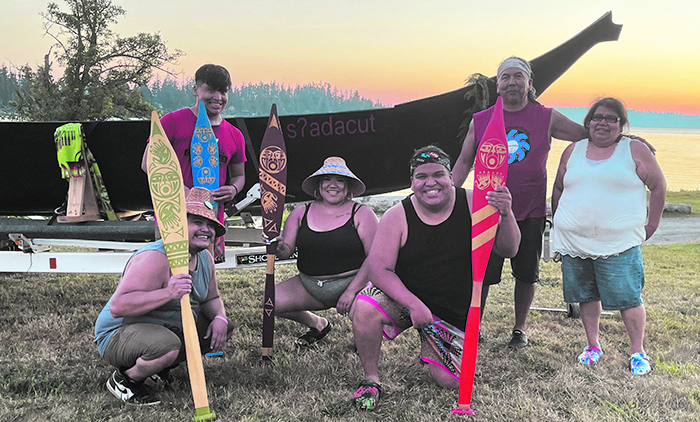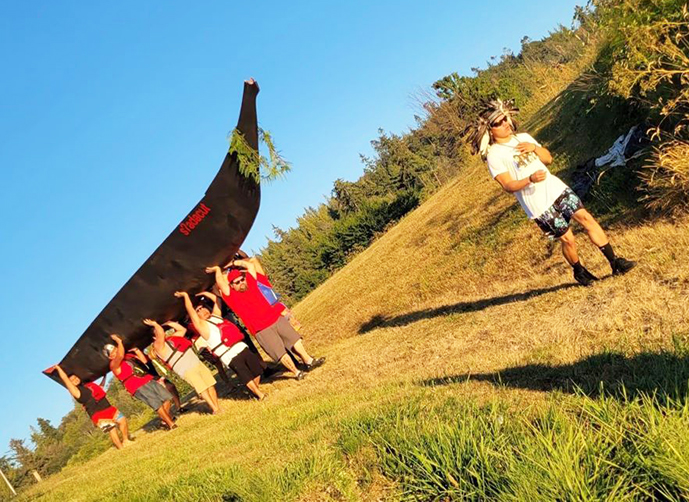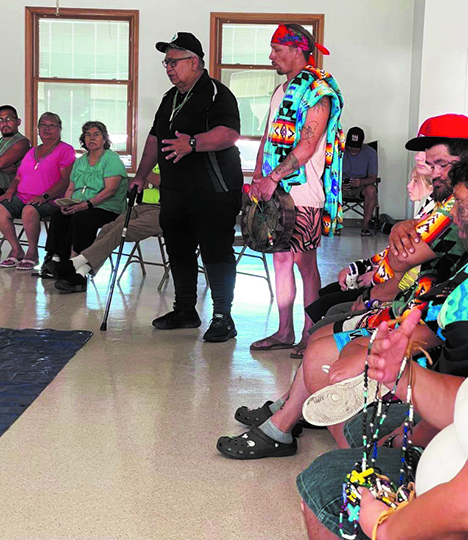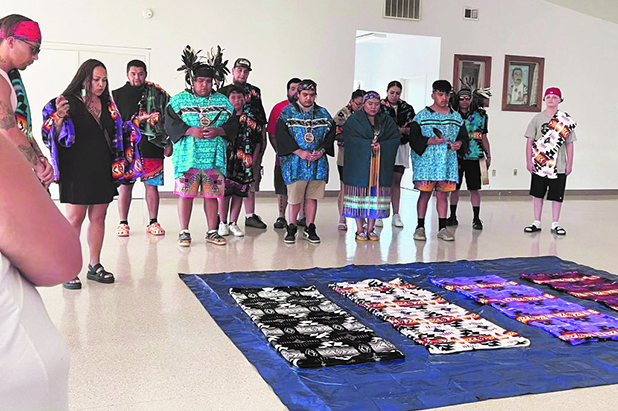
By Shaelyn Smead, Tulalip News; Photos courtesy of Stacey Sam
On July 30, a Tulalip family held a canoe unveiling and naming ceremony for four of their family members, Stacer, Sampson, Saleena and Scotty. The highly anticipated event followed years of the family members attempting to reconnect with their culture and people, and the desire to earn their Indian names.
Naming ceremonies and receiving an Indian name plays an important role in Native American culture. Certain elements and traditions of each ceremony are sacred and specific to it’s given tribe. Nonetheless, each name that is given carries on a piece of our ancestors, and the language that we speak. Rather than their English name, Native Americans can proudly use their new name and be a representation of our people and our perseverance.

Traditionally speaking, Native Americans used to not receive a name at birth, and would instead earn a name that was passed down from their family lineage. The name is typically chosen based on their personality, skills, or similar characteristics and traits that a loved one also once had. These names are taken and used with pride as each person with a given name represents the strengths of the past and the promises of the future.
Stacey Sam is the father to Stacer, Sampson, Saleena, and Scotty. He once lived on the Tulalip Reservation and then went on to spend most of his life at Muckleshoot. Unfortunately, with some familial problems that Stacey faced growing up, he didn’t quite have the connection with his culture as much as he would’ve liked. But, after building a family, and having kids of his own, he was able to watch them grow and see them strive for a culturally-led life.
Scotty was the first of the kids that made an initiative to connect with his culture and asked his brother Stacer to join him. They went out of their way to learn cultural teachings, become more engaged within the community, and create a newfound respect for their people and ancestors. They started by attending Coastal Jams up and down the coast, and eventually became apart of the Canoe Team in Muckleshoot. By doing so, Stacer also found a new love for singing and began performing at jams and ceremonies.
After watching his children and their newly found cultural journey, Stacey was inspired to continue on the path that his children had embarked. He realized they had gone too long without culture in their lives, and wanted a reset for his family. He wanted to establish a new legacy for his family that would last for generations to come. He quickly connected with some tribal elders and Tulalip family, and decided that a family canoe unveiling and naming ceremony would be the perfect next step.

“This is all new to me, but I want to bring that cultural presence back into my family line. My kids have already started and I want to see it through. They helped me pick up the drum, and it’s a blessing to get to know our ways. This journey has opened my eyes with the way we all come together and take care of one another,” Stacey said.
Stacey reached out to George Swanaset Sr. of Nooksak, who is an avid canoe carver, to help build his family canoe. Stacey wanted to be sure the canoe could fit everyone in his family, and that the canoe would hold “S?adacut” on the side, a tribute to his late father William Edward ‘Sonny’ Sam. Being Tulalip himself, it was important to Stacey that the canoe would paddle off into Tulalip Bay.
Shortly after, Stacey reached out to various Tulalip tribal members and asked for their help to ensure the naming ceremony would play out perfectly. Don ‘Penoke’ Hatch who has been a longtime family friend of theirs helped orchestrate and organize the ceremony to ensure it’s traditional ties, “Stacey’s dad was a tremendous friend of mine, and I was glad to be involved” he said. Penoke talked about the importance of having the ceremony, “I’m really proud of what the Sam family is doing. It’s an honor to carry an Indian name. You earn your name, and it’s how you present yourself to your people.”
Marlin Fryberg also helped by researching the Sam family’s lineage to find appropriate names to use and pass on to all four of the children. It was decided that Stacer would carry on his grandfather’s Indian name “S?adacut”, Sampson would carry on “Tsoh-see-oose”, Saleena would hold “Tsee-si-lit-sah”, and Scotty would be named “Tix-tad”. All of the names came from their ancestors and family before them.

Quickly, more and more Tulalip family and community members became involved and helped with painting the canoe, cooking food for everyone in attendance, and establishing themselves as witnesses to the ceremony. What started off as just one family’s journey quickly became a community journey that supported and helped aid the teachings of our people.
On the day of, Tulalip members Thomas Williams and Natosha Gobin stepped up to the plate to help with ceremonial blessings and prayers, and the unveiling of the names. Most of the ceremony was presented first in Lushootseed and then parts in English to instill its traditional roots.
The ceremony couldn’t have gone more perfectly. “I had never been to a naming ceremony before, and I didn’t know what to expect. But once it all took place, I felt very calm and at peace. I feel honored to carry my grandpa’s name. And being so close with my siblings growing up, it meant a lot to do this together,” Stacer said.
The Sam family could feel their ancestors smiling down on them as they took this new step together. They are extremely grateful to everyone who helped them take on this journey and rebuild their cultural ways. Being gifted their Indian names was a fresh start for their family, and created a new sense of pride that they planned to hold onto for the rest of their lives.